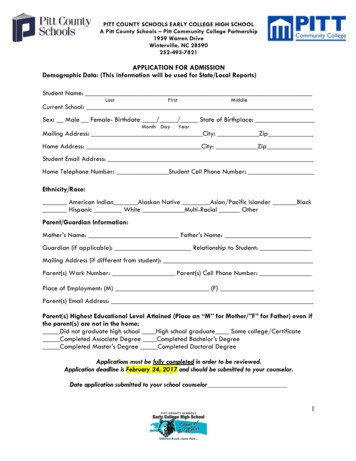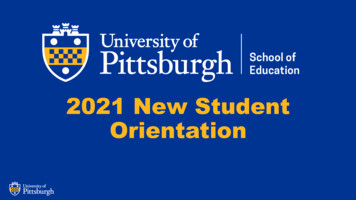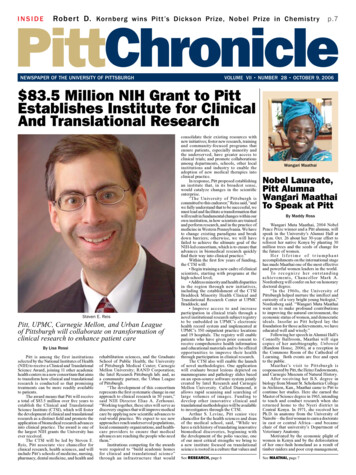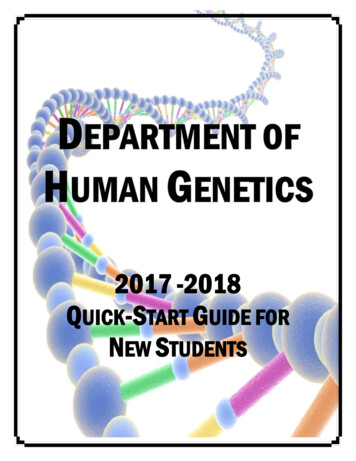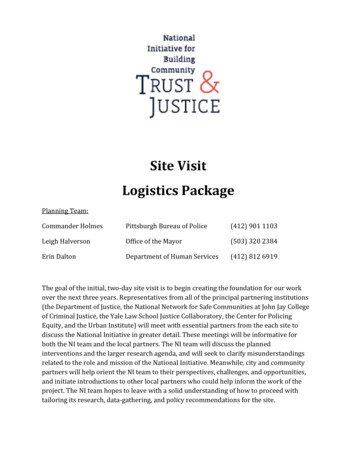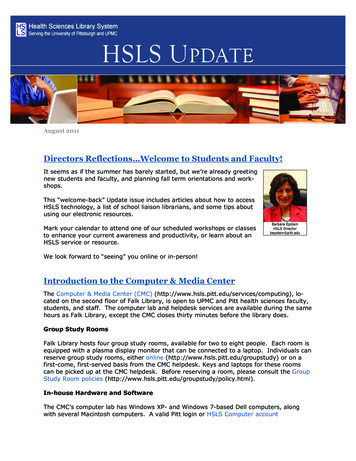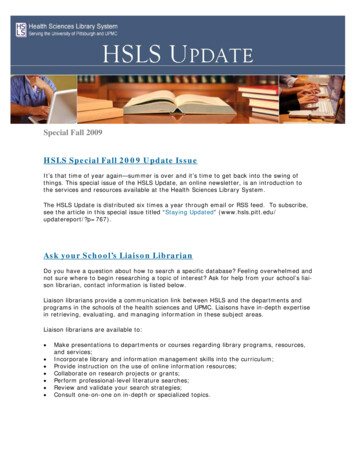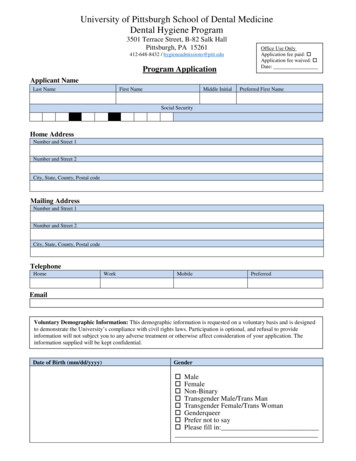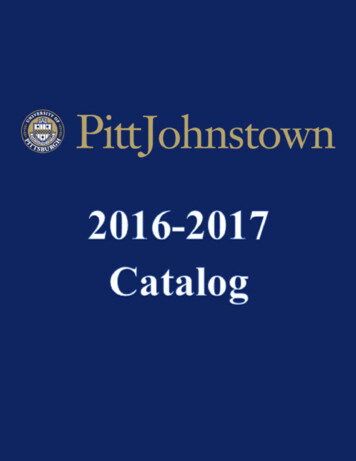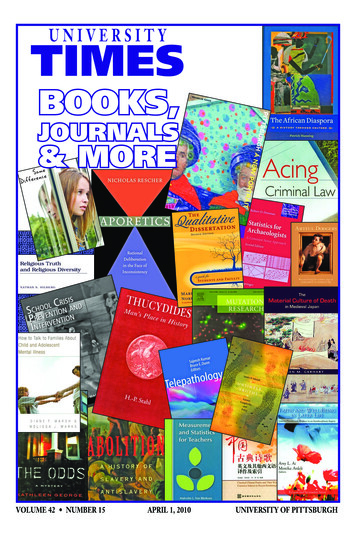
Transcription
UNIVERSITYTIMESBOOKS,JOURNALS& MOREVOLUME 42 NUMBER 15APRIL 1, 2010UNIVERSITY OF PITTSBURGH
U N I V E R S I T Y TIMESU N I V E R S I T YM A T T E R SS E N A T E/ Attilio FavoriniBlue and Gold goes greenHail to Pitt x 5Representatives from all fivePitt campuses were on handto provide information forcollege-bound high schoolersand children of Pitt facultyand staff during the University’s Five Campus CollegeFair, held March 8 in AlumniHall’s Connolly Ballroom.Kimberly K. BarlowSenate election runs April 2-17Electronic balloting forUniversity Senate officersand new Faculty Assemblymembers will begin tomorrow,April 2, and run through April17.Senate officers will serve oneyear terms beginning July 1.Running for president areNicholas G. Bircher, associateprofessor of anesthesiology andcritical care medicine, School ofMedicine; and Michael R. Pinsky,professor of critical care medicine,bioengineering and anesthesiology, School of Medicine.(For a discussion of issues bythe two presidential candidates, seepage 5.)Candidates for vice presidentare Wesley M. Rohrer, assistantprofessor, Department of HealthPolicy and Management, Graduate School of Public Health; andPatricia M. Weiss, reference andinformation technology librarian,Health Sciences Library System.Laura A. Fonzi, clinical instructor, Department of Health andUNIVERSITYTIMESN. J. BrownPeter rly K. low@pitt.eduBUSINESS MANAGERBarbara DelRaso 412/624-4644delraso@pitt.eduEvents Calendar: utcal@pitt.eduThe University Times is published bi-weeklyon Thursdays by the University of Pittsburgh.Send correspondence to University Times,308 Bellefield Hall, University of Pittsburgh,Pittsburgh, PA 15260; fax to 412/624-4579or e-mail: njbrown@pitt.edu.Subscriptions are available at a cost of 12.50for the remainder of the publishing year, whichruns through July. Make checks payable to theUniversity of Pittsburgh.The newspaper is available electronically at:http://www.pitt.edu/utimes/ut.html Physical Activity, School of Education, is running for secretaryunopposed.Newly elected members toFaculty Assembly serve the firstyear of their three-year terms onthe Assembly; during their secondand third years, they serve onboth the faculty-only Assemblyand on Senate Council, whichincludes faculty, staff, studentsand administrators.The following are candidatesfor Faculty Assembly. The numberof vacancies in each unit is indicated in parentheses.School of Arts and Sciences Humanities (2 vacancies):David Bartholomae, English; H.David Brumble III, English; JohnLyon, German; Clark Muenzer, German; Francesca Savoia,French and Italian. Natural Sciences (2): RobertDaley, computer science; VladimirSavinov, physics and astronomy. Social Sciences (1): Chris Bonneau, political science.Professional schools Education (1): Jere Gallagher. Engineering (2): WilliamFederspiel; Jeen-Shang Lin; RonNeufeld. Graduate School of Public andInternational Affairs (1): KevinKearns. Social Work (1): WilliamElliott. University Library System (1):Danielle Colbert-Lewis; MichaelFord; Robin Kear.Schools of theHealth Sciences Dental Medicine (1): SteveWendell. Health and Rehabilitation Sciences (1): Michael Hahn; DebbieMiller; Thomas Platt. Health Sciences LibrarySystem (1): Linda Hartman; FranYarger. Medicine (3): Leonard Baidoo;Carey Balaban; Anthony Bauer;Adeel Butt; Barbara Gaines; KevinHo; Maria Kovacs; Roy Smith;Hussein Tawbi; Ali Zaidi. Nursing (1): Marilyn Hravnak;Donna Nativio. Pharmacy (1): Colleen Culley;Tom Nolin. Public Health (1): JeanineBuchanich; Emilia Lombardi.There are no openings thisyear for new Assembly membersfrom the Katz Graduate Schoolof Business, the School of Lawand the School of InformationSciences.Pitt’s Bradford, Greensburg,Johnstown and Titusville campuses elect their own representatives to Faculty Assembly.The slate of candidates for theUniversity Senate’s 15 standingcommittees is being compiledand is expected to be publishedin a future issue of the UniversityTimes.For more information on theelections, contact the Senate officeat 4-6505.—Peter HartnCOI filing deadline April 15Pitt conflict of interest (COI) disclosure forms must be filed byApril 15. Information on who must file, how to file and a new guidefor supervisors is available at www.coi.pitt.edu/directive.htm.COI disclosures must be filed through the Superform system(https://coi.hs.pitt.edu) by April 15. Management reporting formsand annual data summary reports from supervisors are due May17.Users requiring assistance should click on the log-in page linkor call 412/648-2222.The Superform web site should be used only to fulfill Pitt COI disclosure requirements, not UPMC or University of Pittsburgh Physicians requirements.nThis semester the usual University Senate plenary session willbe incorporated into a sustainability festival, scheduled for April 8and 9 in the William Pitt Union. The festival offers the occasionfor both a reckoning and a celebration of sustainability effortsoccurring in every corner of the campus.April’s “Blue, Gold and Green” event is sponsored by the Office ofthe Provost and the Purchasing Department, both active participantsin an ongoing campus forum for sustainability concerns initiated in2007, when an ad hoc Senate recycling committee metamorphosedinto the sustainability subcommittee of the Senate’s plant utilization and planning committee. The sustainability subcommitteehas been holding three or four meetings each semester, invitingrepresentatives of the many responsibility centers whose activitiesimpact climate change, energy use, pollution, green design andother policies and practices that contribute to or detract from thejudicious management of the environment.Recent discussions at the sustainability subcommittee meetings,which are open to the University community, have consideredideas such as a “green fund” for sustainable campus practicesunderwritten by a student activity fee; a “green gifts” campaign toreach environmentally engaged alumni; a “green dorm” living andlearning center, and an interactive sustainability web site to stimulateawareness and exchange on sustainability issues. Members of theUniversity community interested in attending the sustainabilitysubcommittee meetings should ask Lori Molinaro, lam06@pitt.edu, to add their names to the subcommittee’s distribution list.The sustainability subcommittee has heard from FacilitiesManagement, Food Services, the environmental studies program,the Mascaro Center for Sustainable Innovation, the Office of theExecutive Vice Chancellor, Institutional Advancement, ResidenceLife, Free the Planet, Engineers for a Sustainable World and otherstudent environmental organizations, to name just a few. Subcommittee members regularly interact with counterparts at other localuniversities, the sustainability coordinator of UPMC, the environmental committee of the Oakland Business Improvement District,the Pittsburgh Climate Initiative, the Board of Trustees propertyand facilities committee and many other such organizations. As aresult of the subcommittee’s efforts, the University now maintainsan attractive web site, www.pitt.edu/green.html, on sustainabilityissues. In addition, the University Senate adopted a statementon sustainability in 2008 that originated with the sustainabilitysubcommittee.Merely reciting the roster of interested constituents suggests thechallenges involved in meeting the Senate statement on sustainability’s charge to “identify, implement, communicate and coordinatepractices that preserve and promote efficient use and conservationof energy, water and other resources and increase promotion ofconservation efforts to the University community.”The April “Blue, Gold and Green” event is designed not onlyto inform the campus about successes such as the “RecycleMania”campaign and a growing number of LEED (Leadership in Energyand Environmental Design) certifications for campus buildings,but also to exchange ideas about goal-setting and coordinationof sustainability efforts. On April 8, 11 a.m.-3 p.m., there will beongoing events, including a supplier showcase of green products,a “Sustain-a-Bowl” awarding of prizes to student organizations forsustainable demonstrations and a bicycle-building competition.The day’s activities will be capped with the Heinz DistinguishedLecture delivered by Stuart L. Hart, an expert on sustainabilityand development.Also on April 8 will be the centerpiece event of the festival, thesustainability subcommittee’s panel, “Sustainability at Pitt.” Thepanel is scheduled noon-2 p.m. and will afford ample opportunityfor questions and suggestions. A complementary lunch will beserved; if you plan to attend the lunch session, please RSVP topittgreenteam@bc.pitt.edu.The panel will include: Ward Allebach, adjunct professor in the Department of Geology and Planetary Sciences, who will discuss issues that studentsare focused on within the environmental studies program. Bernard Goldstein, professor of environmental and occupational health, who will provide a historical perspective on theenvironmental movement and will discuss personal responsibilityin promoting sustainability. Jodi Ludovici, general manager of Sodexho, who will discusssustainable policies and practices that Sodexho and Dining Serviceshave in place on campus. Allison Robinson, director of environmental initiatives atUPMC, who will discuss the structure and aims of UPMC sustainability initiatives and how to move the sustainability agendaforward in a large, complex organization. Laura Zullo, senior manager in Facilities Management, whowill discuss how sustainability is figured into its projects and willprovide an update on LEED certification.The second day, April 9, will include a student sustainabilitysymposium and a sustainable career forum. For a fuller descriptionof “Blue, Gold and Green,” go to www.bluegoldandgreen.pitt.edu/index.html.nAttilio Favorini, a faculty member in theatre arts, is chair of the Senate’ssustainability subcommittee.
APRIL 1, 2010HEALTH CARE REFORMWhat does it mean for Pitt employees?As details emerge aboutthe impact of the sweeping health care reformapproved last week, Pitt facultyand staff are pondering its impacton the University and its employees.Health economics professor Judith R. Lave, chair of theDepartment of Health Policy andManagement, said she believes thehealth care reform legislation willhave more impact on Pitt’s medical side than on individual facultyand staff, noting that the benefitsprovided to faculty and staff underthe University’s insurance planslargely are consistent with theaims of the legislation.One impact on individuals, shesaid, is that some high-incomeemployees eventually will see theirpayroll taxes rise. The legislationcalls for Medicare payroll taxes toincrease in 2013 from the current1.45 percent to 2.35 percent ofwages for individuals who earnmore than 200,000 in wagesor couples who make more than 250,000.Closer on the horizon are anumber of other changes. According to a statement from the WhiteHouse Office of Health Reform,these are among the key provisionsof the legislation that take effectthis year: Children with pre-existingconditions no longer may bedenied coverage. Young people may remainon their parents’ insurance policyuntil they turn 26. Insurance companies will bebanned from dropping people whobecome ill and may not implementlifetime caps on coverage. New private plans will berequired to provide free preventive care with no co-payments ordeductibles.(Links to the 2,074-pageSenate bill and the House changesare available at itt director of Benefits JohnKozar said his department is examining the potential longer-termimpacts of the legislation, but heexpects no changes now for Pittemployees covered by Universityhealth insurance plans.“The immediate issues havebeen addressed long ago,” he said,noting that Pitt employee healthplans do not exclude people withpre-existing conditions nor isthere a lifetime maximum benefitor cap.In addition, the Universityoffers health plans that includepreventive care and Pitt alreadyextends health insurance benefitsto qualifying adult children. Astate law that took effect lastJune allows employers to providecoverage to employees’qualifyingsingle adult children up to age 30,at the parent’s expense. (See Nov.12, 2009, University Times.)Details on Pitt health insur-ance benefits are available atwww.hr.pitt.edu/benefits/medical.htm.Lave said the bigger impacthere will be on the hospitals: “Itwill have an impact on the numberof insured people who will cometo the medical center.” On theother hand, the bill also decreasespayments to health care providers,“but don’t blame this bill for that,”Lave said. “If they hadn’t put it inthis bill they would have done itanyway in another bill.”Jacqueline Dunbar-Jacob,dean of the School of Nursing,praised the provisions of the billthat expand health care access.“This legislation seemed tobe about availability,” she said,but added there still is room toimprove the quality and efficiencyof the nation’s health care deliverysystem.Citing the U.S.’s rankingbehind 27 other industrializednations in health care outcomes,Dunbar-Jacob said, “We needto be looking not only at peoplehaving access; providers need tolook at ways to improve the qualityof outcomes. There’s considerableroom for improvement.“This legislation gives us a realchance to help reduce the differences in populations in health careoutcomes.”Dunbar-Jacob noted the current shortage of primary care providers and said that the legislationtake down the main tower as well— but we have to move programsthat are in there — and thenconstruct a new bed tower forPresbyterian,” she said. “Presbyterian and Montefiore are agingand the rooms are rather small tohold the technology for today, sowe do have plans for that.”Asbestos removal currentlyis underway inside the DeSotowing, said Tom Schwartzmier,senior project manager for planning, design and construction forUPMC Presbyterian Shadyside.A demolition contractor hasyet to be selected, but Schwartzmier said the DeSoto wing couldstart to come down in a matterof weeks.“Our goal is to try to begindemolition work sometime aroundthe first of May,” he said. “It’s mygoal to get the majority of thisdone, if we can, when the Pitt students aren’t here for the summer.Oakland’s much slower when thePitt students aren’t here, whichmeans the traffic situation’s betterfor trucks taking debris away.”It’s for the birdsMichelle KienholzAbove: A nesting site for red-tailed hawks probably wasn’twhat the late Pitt professor and artist Virgil Cantini had inmind when he created “Man,” the sculpture on the GraduateSchool of Public Health.Department of Medicine staffer Michelle Kienholz, who hasbeen watching the birds from her office in the Medical ArtsBuilding across Fifth Avenue from Parran Hall, said the birdshave built their nest using branches from nearby street trees.She has observed them diving to hunt pigeons, squirrels andother rodents on the surrounding grounds, undaunted by hospital helicopters and Oakland traffic, she said.Meanwhile, at the peregrine nest atop the Cathedral of Learning, below, five eggs are being incubated by the residentfalcon pair, Dorothy and E . This year’s egg count representsan extra effort by Dorothy, who in past years has laid foureggs.Hatchlings should appear in late April and will be banded bythe Pennsylvania Game Commission as the birds prepare tofledge about a month later.Additional photos of the peregrine nest from the NationalAviary falcon cam can be found at www.aviary.org/cons/falconcam .php; a video falcon cam is online at www.aviary.org/cons/falconcam cl.php.CONTINUED ON PAGE 10Former Children’s site going green, both now & laterPlans to level the formerChildren’s Hospital’sDeSoto wing will leaveOakland with some new greenspace, at least temporarily.UPMC intends to tear downthe structure, which faces FifthAvenue and extends along DeSotoStreet across from Pitt’s Graduate School of Public Health, thisseason. The taller main hospitaltower will stay standing for thetime being.Replacing the DeSoto wingwill be an expansive lawn withtrees lining the perimeter. The busstop on the Fifth Avenue side ofthe property will be expanded andadditional seating installed.UPMC planners told members of the Oakland BusinessImprovement District last weekthat the hospital tower and thegreen space eventually will bereplaced by a new building forwhich UPMC intends to pursueLEED certification.Before that can happen, however, current occupants of themain tower will need to be relocated over the next several years.Offices will be moved, radiologyservices will be consolidated intoUPMC Presbyterian, clinicallabs in the tower will be movedto the Rangos Building and theheliport will be relocated to theUPMC Presbyterian rooftop, saidDenise Rafferty, director of planning, design and construction forUPMC Presbyterian Shadyside.“We expect this green spaceto remain as is perhaps for threeto four years or so. Eventuallywe’d like to do a larger project,Demolition is scheduled towrap up in mid-October andplantings are expected to be inplace by winter, if all goes according to plan.Exactly how the building willcome down has yet to be determined, but it won’t be by dramaticmeans such as an implosion orwrecking ball, said Schwartzmier.More likely, he said, is that thebuilding will be demolished in“bites” by jawlike equipment, ortaken apart with hammers.The work will be done duringArtist’s rendering of the green space that temporarily will replace the DeSoto wing of the oldChildren’s Hospital building.the day, with stations installedaround the site to monitor dust.“We want to try to make this a veryclean site with the least amountof disruption to what’s going onin the community as possible,”he said.“It helps the community but italso helps our adjacent hospitalstoo. I think everyone wins if we cankeep the dust down and do this ina very green type of a way.”The demolition itself will giveUPMC a head start on LEEDcertification for the building iteventually plans to erect on thesite.“To that end, we’re going totake a lot of the rubble that’s goingto be knocked down and actuallyuse it to fill in the hole that willremain when the building’s demolished,” Schwartzmier said. Twobasement levels would be filledwith brick and cement rubble, hesaid, estimating they extend about25 feet below ground level.Schwartzmier said the planis to start from the Fifth Avenueside of the building nearest to FalkClinic and demolish that portionof the wing first, then continuealong Fifth and up DeSoto Street,finishing on the side nearest theUPMC Presbyterian emergencydepartment entrance.The demolition may be ableto be done without relocating thebusy bus stop on Fifth Avenue,Schwartzmier said, althoughcontingency plans have been madeto move the stop to a temporaryspot in front of Falk Clinic if thecontractor deems it necessary.—Kimberly K. Barlown
U N I V E R S I T Y TIMESMajor bus route changes begin April 4“Change is coming.Get on board” is themantra of the PortAuthority of Allegheny Countyas it gets ready to implement thelargest bus service changes in 50years beginning April 4.Port Authority and Pitt officials gathered at Alumni Hall lastweek to present the route andother service changes, which willbe implemented in phases over thenext two years, in a town hall-stylediscussion sponsored by the StaffAssociation Council.Wendy Stern, assistant generalmanager of the transit authority,gave an overview of the rationalebehind the changes, and FredMergner, assistant manager ofscheduling, discussed specificroute changes for Oakland’smore than 30 daily routes. (Seesidebar.)With all the changes to thecounty’s demographics in the past50 years, Stern said, the time fora major overhaul of services hadarrived. As additional incentive tochange, Act 44 legislation passedtwo years ago dictates how muchstate funding the Port Authorityreceives based on a formula thatrewards efficiency and penalizesinefficiency, she noted.The first changes start April4, with 60 routes affected systemwide. The next phase of routechanges will be implemented inJune, with others planned forSeptember. The new transit planis expected to be implementedfully by March 2012.Stern said the goal is to providemore service with fewer routes.“Right now we have 186 routesand we’re proposing to reducethat to 122 routes, a 35 percentdecrease,” Stern said. “However,the number of weekday bus tripswill be increased by 6 percent(from 7,373 to 7,805) and theaverage number of trips per routewill be increased by 60 percent(from 40 to 64 trips per route onaverage).”That is expected to provideriders with greater scheduleflexibility, make the system lesscomplicated and reduce serviceduplication, she said. “We arereallocating our resources awayfrom unproductive and underproductive routes to those wherethe demand is the highest,” Sternsaid.Some of the other features ofthe transit plan that will be implemented by 2012 include: Rapid buses. Rapid busesare proposed for nine routes: the61-series routes, the 71-seriesroutes and the 28X Airport Flyer.Implementation of the rapid busesis planned for fall-winter 2011.Some of the features of rapidbuses, Stern said, include morefrequent service; fewer stops, sotravel time is quicker; a simpleroute structure; enhanced stationswith passenger amenities, such asbike racks and more parking, andreal-time passenger informationbased on a GPS tracking system.The Port Authority is workingwith the city to grant the rapidbuses priority over automobileson certain streets, she added.“The other nice thing aboutthe rapid bus concept is that it isscalable over time, as resourcesbecame available,” Stern said.“Although we don’t have all the resources now to implement allthe features I just listed, over timewe expect to be able to achieve allof that.” Bus stop consolidation.Stern said the Port Authoritycurrently operates 186 routeswith more than 16,000 bus stopssystem-wide. Industry best practices suggest that many of the stopsare spaced too close together forefficiency, so the transit companywill be eliminating some and shifting others on many routes, shesaid. New signs will be posted atstops as the routes are adjusted.In most cases, the additionaldistances that passengers will haveto walk will be one or two blocks,Stern said. A new route identificationsystem. For example, the EastBusway vehicles will be purple;all East Busway routes will have a“P” prefix. A G (for green) prefixwill identify the West Busway; anR prefix will identify rapid busroutes; an L will designate limitedstop routes.A and B suffixes will be used inlimited circumstances for routesthat have branches at their outerends, for example, the 77A and77B. Numbers only will be usedfor all other routes. Expansion of parking. “Werecognize we have a critical shortage of parking around the region,”Stern said. The Port Authorityplans to expand parking at 15high-priority locations around thecounty, although no timetable isset due to the current lack of funding. Changes for each phase willinclude plenty of advance publicnotice, she added.“We know that not everybodywill be thrilled by these changes,”Stern said. But for nearly 90 percent of riders, the basic routes willremain the same. About 10 percentwill lose their current route butWill yourOaklandbus servicebe affected?When the Port Authoritybegins to implementchanges in its routesystem, much of Oakland’s busservice will be affected.Fred Mergner, assistant manager of scheduling, itemized routechanges for Oakland’s 32 dailyroutes.“On April 4, we’re changing atotal of 60 routes system-wide, 13of which travel through Oakland,”Mergner told an audience of about100 here March 25. Highlights ofthe Oakland bus route changesinclude: The 61 series buses eventually will become part of the rapidbus network, but in the short termwill retain their current routenumber designations.“However, on all the 61 seriesroutes — 61A, B, C and D —entirely new schedules have beendeveloped in accordance with thetransit plan,” Mergner said.“You will notice increasedservice levels: Throughout theday, each one of the 61 series willrun every 15 minutes, meaning 16trips an hour between Oakland andForbes and Murray. Secondly, the61C and 61D, which use MurrayAvenue, will be scheduled to alternate evenly, just as the 61A and 61Bthat continue out Forbes Avenuewill be designed,” he said.Thus, at Forbes and Murrayavenues in Squirrel Hill, buses arescheduled to arrive A, B, C, D, A,B, C, D, Mergner said.“Because they are evenlyspaced, we’re hoping it will reducethe ‘bunching’ or ‘platooning,’where several buses arrive at a stopat the same time,” he said. The 61C has some slightroute changes in the McKeesportarea. Those will be implementedon April 4. The 61D, which currentlygoes up Forward Avenue to Summerset at Frick Park, no longerwill turn at Murray and Forwardavenues. That bus will continueon Murray Avenue to The Waterfront. It will be renamed 61DMurray. It also will expand toseven-day-a-week service. On April 4, the 59U will beeliminated. The 69A bus, which duplicates much of the 61C route, alsowill be discontinued April 4. The 61A and 61B havesome substantial routing changesplanned near the end of the linein the eastern suburbs. However,those changes will not be implemented until the rapid bus phaseis undertaken, planned for fallwinter 2011. The 61F-Homestead Parkalso will be discontinued. To getfrom Oakland to Homestead Park,riders will take a 61C and transferto a 53F or 55M in Homestead, ortake a 61D-Murray to The Waterfront and transfer to the 55M. The 64A, which currentlyoperates between Homestead,Squirrel Hill and Shadyside, willbe rerouted and renamed the 64Lawrenceville/Waterfront. Thenew route will operate betweenLawrenceville, Bloomfield, Shadyside, Squirrel Hill, Greenfieldand The Waterfront.Service between Negley andCentre avenues and East Liberty,as well as service along EighthAvenue and Amity Street inhave reasonable alternatives, andless than one-half percent of riderswill have their service eliminated,she said.qBill Seman, director of treasuryoperations for the Port Authority,discussed the new fare box system,which will read Pitt’s smartcardIDs system-wide once the fareboxes have been installed in PortAuthority vehicles, a project slatedfor completion this fall.Seman said the card must bewithin about 2 inches of the farebox scanner to register. The riderwill hear one sound if the cardhas been accepted as valid and adifferent sound should the cardbe rejected, he said.The only information conveyed to the Port Authority viaPitt’s smartcards is the uniquenumber embedded in the cardthat alerts the transit company’sscanners of the card’s validity.No personal data are forwarded, said Jessica Larson ofPanther Central.Kevin Sheehy, director of Parking, Transportation and Services,added that Pitt has the capabilityof differentiating whether the cardholder is a student, staff memberor faculty member, but that information is not shared with the PortAuthority.—Peter HartnPrinted schedules for all bus routes now are available.Riders also can access information on any bus route pril4Final.pdf.The site also details the changes, if any, on every routeand includes both the current bus designation and itsnew designation, where applicable.The Port Authority also has added customer servicestaff, who can be reached at 412/442-2000.Homestead, will be discontinuedApril 4. The new 75-Ellsworth routewill replace the 59U betweenOakland and the South SideWorks. The new 75-Ellsworthbus will start daily at 6 a.m.; the59U did not run during morningrush hour. The 75-Ellsworth eventually will replace the 71C, whichserves Shadyside via EllsworthAvenue, although no timetable forthe replacement is set. Inbound,the 75-Ellsworth will run fromBakery Square to Shady Avenuedown Ellsworth Avenue to Neville Street to Fifth Avenue to theBirmingham Bridge to the SouthSide Works seven days a week. The71C eventually will not travel onEllsworth Avenue and instead willoperate on Centre Avenue when itbecomes a rapid bus. The 71A alsowill be converted to a rapid bus.Mergner said, “The importantthing to remember in the shortterm is that the 75-Ellsworthand the 71C routes are interchangeable between Oakland,and College Street and Ellsworthin Shadyside. If you see the 75coming, use it, because the 71Cfrequency has been reduced inthe interim time period prior toimplementation of the rapid busphase.” Two Shadyside routes, the77C and the 78C-ShadysideExpress, will be discontinuedApril 4.“However, the 78C ridershipon Bayard Street will be served bya rerouted W-Wilkins AvenueFlyer that riders can take to get toDowntown,” Mergner said. Two routes currently runfrom Oakland/Downtown to theairport area: The 28X AirportFlyer and the 100 West BuswayAll Stops. The 28X route willeliminate the Robinson TownCentre stop, going from Oaklandto Downtown and then directly tothe airport. The service will runevery 30 minutes from approximately 4:30 a.m. to midnight,seven days a week. Eventually, the28X will become a rapid bus, butwill retain its route designationfor now.The 100 West Busway-AllStops route will be renumberedand renamed G2 West BuswayOakland. That bus will run toRobinson Town Center directlyfrom Oakland and Downtown.The G2 West Busway-Oaklandwill run seven days a week all daylong. Currently, the 100 WestBusway-All Stops runs only duringweekday rush hours.The G2 will not serve theCarnegie park-and-ride as the100 West Busway-All Stops doescurrently.“For those of you who use theCarnegie park-and-ride, thereare several options,” Mergnersaid. “There is a park-and-rideat Bell Station, Crafton Stationand Sheridan Station on theWest Busway, or if you use theCarnegie park-and-ride you cantake the G
UPMC Presbyterian, clinical labs in the tower will be moved to the Rangos Building and the heliport will be relocated to the UPMC Presbyterian rooftop, said Denise Rafferty, director of plan-ning, design and construction for UPMC Presbyterian Shadyside. "We expect this green space to remain as is perhaps for three to four years or so.
